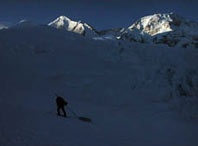Cold Toes
We've moved up to our camp at 11,000
feet, having strained under
heavy packs and dragging sleds laden with the bare essentials that
we'll require for the next two days. We arrived at 3:30 a.m. and
still had an hour of work to do pitching tents onto the sloping site
and battening our gear down in case of high winds or snow. Nothing
can be left on its own: duffels, backpacks, sleds, ski poles, and
ice axes must all be tied down by slings and carabiners to snow
pickets buried deep in the slope. By morning, a storm was upon us,
in typical Denali style, with whiteout conditions from blowing
sheets of snow and spindrift. Half our team, led by
Colby Coombs, hiked
down to our cache of food and equipment buried at 9,700 feet, to
drag it all back up on sleds. The other half stayed in camp to build
snow block walls around our tents to buffer them from the high
impact of wind and accumulating snow. (To see the route from Base
Camp to the summit, go to
Climb.)
Since we've arrived, high winds and poor visibility have prevented
anyone from moving up to the Medical Camp at 14,200 feet.
Howard Donner and
Pete Athans made an
attempt to move higher, but were blown back to camp at 11,000 feet.
"The winds were upwards of 60 miles per hour and I was knocked off
my feet. Our sleds literally became airborne," said Donner, his
whiskered face frosting over in the bitter wind. We spend our time
repairing snow walls and brushing snow from our tents while
preparing mentally for the climb ahead.
For most of us, having both the world's authority on altitude and an
astronaut in our midst has been a treat. Dr.
Peter Hackett and
John Grunsfeld
attract audiences at each camp; they are celebrities of the highest
sort for climbers curious about physiology and modern-day
exploration. Although Grunsfeld (who has reached superhuman status
among us landlubbers) has traveled higher than all of us, his
physiologic response to the altitude and cold on Denali is all too
human. The following is a report from Grunsfeld on the body
temperature measurements he has conducted up to our current
elevation at 11,000 feet on his quest for Denali's summit:
Grunsfeld Report
Camp-bound at 11,000 feet by strong winds and snow. Our activity
consists primarily of building snow walls constructed out of blocks
of snow cut from drifts on the side of the mountain. On the way from
our camp at 7,900 feet to our perch here at 11,000 feet I was fully
instrumented with both the core body temperature monitor and the
skin temperature harness.
The core temperature is measured by the small pill that radios its
temperature to a receiver I carry in my mountain bibs. The skin
temperature harness has small wires with thermisters at their ends.
These devices have a resistance that varies strongly with
temperature. The data is recorded by a small electronic logger that
I also have in my bibs. While the core measurements are
automatically made every minute, the skin temperature is only
sampled every 10 minutes and will be downloaded after we return from
Denali. For the climb up to 11,000 feet and for the last two days
I've had the sensors attached to my big toe, my foot, my left thumb,
and on the side of my chest. Periodically I can check the
temperature of my toe and my chest with a small meter.
We're very interested on this expedition in any correlation between
skin temperature and body core temperature. So far my core
temperature has remained relatively constant, around 99°F
while in camp. While climbing it seems to rise to about 101°F,
but drops quickly when we stop for a rest, with core temps so far as
low as 95°F, which may be influenced by drinking cold water.
During the night my core temperature drops to about 96°F in my
warm sleeping bag.
My toe skin temperature has seen extremes of temperature and
presents for me my biggest concern climbing Denali. For most of the
climb from 7,900 feet to 11,000 feet my feet felt warm, but after
our third rest stop at about 10,000 feet my feet began to get cold.
This was likely due to a combination of mild hypoxia and cold as we
ascended to higher altitude. Once we got to camp I measured the
temperature of my big toe and found it to be 42°F! Yet in spite
of the frigid temperature, I still had feeling in my toes. At the
same time my chest temperature was a balmy 88°F. I hope I can
keep my feet warmer as we climb higher on the mountain. This, it
appears, will be my most serious challenge.
Moving in and out of our tents with the blowing snow is kind of like
being on the space shuttle with its airlock. First we must enter the
vestibule, opening and closing the fly—the outside protection
of the tent. Once in the vestibule we brush all the snow off
ourselves and only then can we open the inner door and enter the
protection of the tent. Last night the sound of the wind blowing on
the walls of the tent as I drifted off to sleep was somewhat
disconcerting, but at the same time soothing as I drifted off to
sleep. Today, while temporarily marooned here at the 11,000-foot
Camp awaiting an uncertain break in the weather, I miss the warmth
of my family.

Location: 11,000-foot Camp
Altitude: 11,000 feet
Air Temp: 20°F
Windspeed: 20 mph

|


|
The expedition did not arrive at 11,000-foot Camp until
3:30 am.

|
|
|

